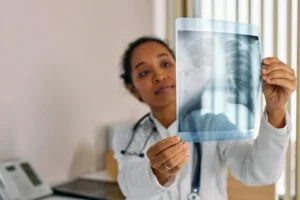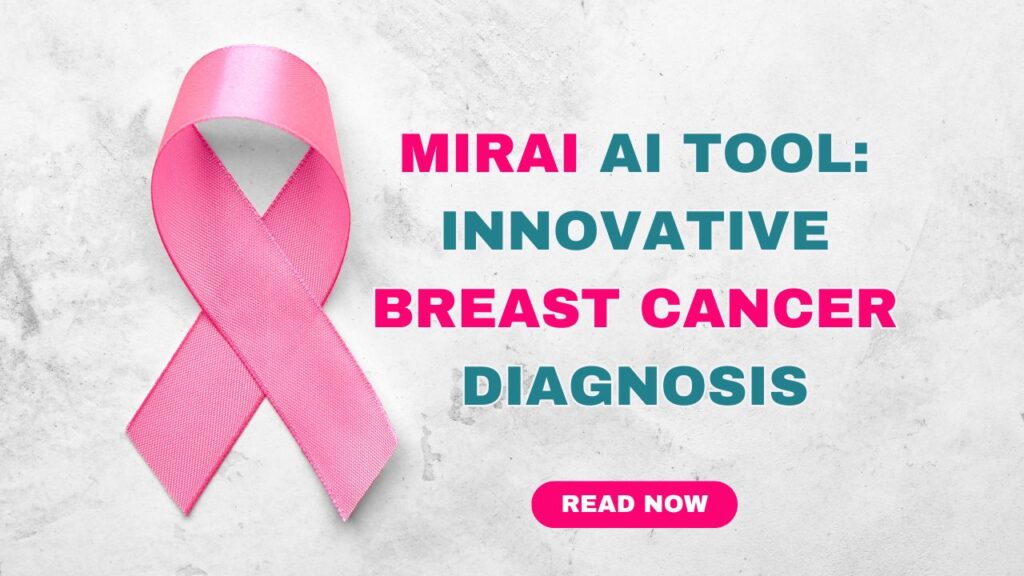Introduction
Breast Cancer can be detected early, diagnosed more accurately, and treated more effectively. This isn’t a distant dream—it’s becoming reality thanks to MIRAI, an innovative artificial intelligence system( AI TOOL) revolutionizing breast cancer diagnoses. 🎗️
In the high-stakes arena of cancer detection, where every moment counts, MIRAI stands as a beacon of hope. This cutting-edge AI technology is not just improving diagnostic accuracy; it’s potentially saving lives. But how exactly does MIRAI work? And what does its integration into clinical practice mean for patients, doctors, and the future of breast cancer care?
From understanding the intricacies of MIRAI’s AI-powered detection capabilities to exploring its impact on early diagnosis and patient outcomes, we’ll delve into the transformative potential of this technology. We’ll also examine the ethical considerations that come with AI in healthcare and peek into future developments. Join us as we unravel how MIRAI is reshaping the landscape of breast cancer diagnoses, one scan at a time.

Defining MIRAI and its purpose
MIRAI is an advanced artificial intelligence system designed specifically for breast cancer detection. Its primary purpose is to enhance the accuracy and efficiency of mammogram analysis, ultimately leading to earlier and more reliable breast cancer diagnoses.
Advantages over traditional diagnostic methods
MIRAI offers several significant advantages over traditional breast cancer diagnostic methods:
-
Increased accuracy
-
Faster analysis
-
Reduced human error
-
Consistent performance
-
Ability to detect subtle abnormalities
| Traditional Methods | MIRAI |
|---|---|
| Prone to human error | Consistent analysis |
| Time-consuming | Rapid results |
| Variable accuracy | High accuracy rates |
| Limited pattern recognition | Advanced pattern recognition |
| Fatigue-affected performance | Tireless performance |
How MIRAI works in analyzing mammograms
MIRAI utilizes deep learning algorithms to analyze mammogram images with exceptional precision. The AI system processes vast amounts of data, identifying patterns and anomalies that might be overlooked by human radiologists. Here’s a simplified breakdown of MIRAI’s analysis process:
-
Image input: The mammogram is digitally scanned and input into the MIRAI system.
-
Pre-processing: The image is enhanced and standardized for optimal analysis.
-
Feature extraction: MIRAI identifies key features and patterns within the mammogram.
-
Anomaly detection: The AI compares the extracted features against its extensive database of known cancer indicators.
-
Risk assessment: MIRAI calculates the probability of malignancy based on its findings.
-
Results output: The system generates a detailed report for review by healthcare professionals.
By leveraging advanced machine learning techniques, MIRAI can detect subtle indicators of breast cancer that may be invisible to the human eye, potentially leading to earlier diagnoses and improved patient outcomes.
Now that we understand what MIRAI is, let’s explore its significant impact on early breast cancer detection. MIRAI’s advanced AI algorithms have revolutionized the screening process, offering numerous benefits to both patients and healthcare providers.
A. Faster screening process and results
MIRAI dramatically reduces the time required for breast cancer screening. Traditional methods often involve long waiting periods, but MIRAI can analyze mammograms in a fraction of the time. This efficiency translates to:
-
Quicker turnaround times for results
-
Reduced patient anxiety
-
Increased screening capacity for healthcare facilities
B. Enhancing detection of subtle abnormalities
One of MIRAI’s most impressive features is its ability to detect subtle abnormalities that human radiologists might miss. This enhanced detection capability:
-
Identifies early-stage cancers more reliably
-
Improves the chances of successful treatment
-
Increases overall survival rates
C. Reducing false positives and unnecessary biopsies
MIRAI’s advanced algorithms significantly reduce the occurrence of false positives, leading to:
| Benefit | Impact |
|---|---|
| Fewer unnecessary biopsies | Reduced patient stress and healthcare costs |
| Improved resource allocation | More efficient use of medical staff and equipment |
| Enhanced patient trust | Increased confidence in screening results |
D. Improved accuracy in identifying potential tumors
The AI-powered system demonstrates remarkable accuracy in identifying potential tumors. This improvement in accuracy:
-
Enables earlier intervention for confirmed cases
-
Allows for more personalized treatment plans
-
Reduces the likelihood of missed diagnoses
As we move forward, it’s crucial to consider how MIRAI can be effectively integrated into clinical practice to maximize these benefits.

Combining AI insights with human expertise
The integration of MIRAI in clinical practice represents a paradigm shift in breast cancer diagnosis. By combining AI insights with human expertise, healthcare providers can achieve a more accurate and efficient diagnostic process. Here’s how this synergy works:
| AI Contribution | Human Expertise |
|---|---|
| Rapid image analysis | Clinical context interpretation |
| Pattern recognition | Patient history consideration |
| Consistent performance | Emotional support for patients |
| Large dataset processing | Final decision-making |
This collaborative approach ensures that the strengths of both AI and human specialists are leveraged for optimal patient care.
Overcoming resistance to AI adoption
Despite the potential benefits, there may be resistance to adopting AI technologies like MIRAI in clinical settings. To overcome this, healthcare institutions can:
-
Provide comprehensive education on MIRAI’s capabilities and limitations
-
Demonstrate MIRAI’s effectiveness through pilot programs and case studies
-
Address concerns about job security by emphasizing AI as a supportive tool
-
Involve clinicians in the implementation process to foster a sense of ownership
Training healthcare professionals to use MIRAI
Effective training is crucial for the successful integration of MIRAI. A well-structured training program should include:
-
Hands-on sessions with MIRAI software
-
Understanding of AI algorithms and their interpretation
-
Best practices for incorporating MIRAI results into diagnostic workflows
-
Regular updates on MIRAI’s evolving capabilities and limitations
By investing in thorough training, healthcare professionals can confidently use MIRAI to enhance their diagnostic capabilities and improve patient outcomes.
With MIRAI successfully integrated into clinical practice, the next logical step is to examine its impact on patient outcomes. This brings us to our next section, where we’ll explore how MIRAI is improving the overall breast cancer care journey.
MIRAI’s implementation in breast cancer diagnostics has shown promising results in enhancing patient outcomes across various aspects of care. Let’s explore how this AI-powered tool is making a difference.
A. Earlier intervention and treatment
MIRAI’s advanced algorithms enable faster and more accurate detection of breast cancer, leading to earlier interventions. This timely diagnosis allows medical professionals to initiate treatment sooner, potentially improving the patient’s prognosis.
B. Potential for better long-term survival rates
By facilitating early detection and intervention, MIRAI contributes to improved long-term survival rates for breast cancer patients. Studies have shown a strong correlation between early diagnosis and better survival outcomes.
| Stage at Diagnosis | 5-Year Survival Rate |
|---|---|
| Stage 0 or I | 99% |
| Stage II | 85% |
| Stage III | 66% |
| Stage IV | 27% |
C. Reducing anxiety through more accurate diagnoses
MIRAI’s high accuracy in breast cancer detection helps reduce false positives and negatives, leading to:
-
Fewer unnecessary biopsies
-
Decreased patient anxiety
-
Increased trust in diagnostic results
D. Personalized risk assessment
MIRAI’s capabilities extend beyond detection to provide personalized risk assessments. This feature enables:
-
Tailored screening schedules
-
Customized prevention strategies
-
More informed decision-making for patients and healthcare providers
By leveraging MIRAI’s advanced capabilities, healthcare professionals can offer more targeted and effective care, ultimately leading to better patient outcomes in breast cancer management. As we continue to refine and expand MIRAI’s applications, it’s crucial to consider the ethical implications and challenges that come with integrating AI into healthcare.

As we delve into the ethical aspects of MIRAI in breast cancer diagnoses, it’s crucial to address the various challenges that come with implementing this advanced AI technology in healthcare.
Maintaining human oversight in diagnoses
While MIRAI offers impressive diagnostic capabilities, it’s essential to maintain human oversight in the decision-making process. Radiologists and oncologists should use MIRAI as a complementary tool rather than a replacement for their expertise. This approach ensures:
-
Accurate interpretation of results
-
Consideration of patient-specific factors
-
Ability to explain findings to patients
Addressing potential biases in AI algorithms
AI algorithms, including MIRAI, may inadvertently contain biases that could affect diagnostic accuracy across different patient populations. To mitigate this risk:
-
Diverse training data: Ensure the AI is trained on a diverse dataset representing various ethnicities, ages, and breast tissue types.
-
Regular audits: Conduct frequent evaluations to identify and correct any biases in the algorithm.
-
Continuous improvement: Update the AI model with new, diverse data to enhance its performance across all patient groups.
Future Developments and Potential
As we look ahead, the potential for MIRAI in breast cancer diagnoses and beyond is truly exciting. Let’s explore the future developments that could revolutionize cancer detection and treatment.
Expanding MIRAI’s application to other types of cancer
While MIRAI has shown tremendous promise in breast cancer detection, its potential applications are far-reaching:
-
Lung cancer screening
-
Prostate cancer diagnosis
-
Skin cancer identification
-
Brain tumor detection
By adapting MIRAI’s algorithms to different cancer types, we can improve early detection rates across various oncological fields.

While the benefits of MIRAI are clear, it’s crucial to address the ethical considerations and challenges associated with AI in healthcare. As we look to the future, ongoing research and development will likely expand MIRAI’s capabilities, potentially leading to even more accurate and personalized breast cancer detection methods. Embracing this technology responsibly and collaboratively will be key to maximizing its potential and ensuring the best possible care for patients in the fight against breast cancer.
Follow Elixir Care for latest updates and innovations in cancer detection https://x.com/extendinghealth
Read More Elixir Care Blog and Empowering Yourself https://elixircare.net/blog/

